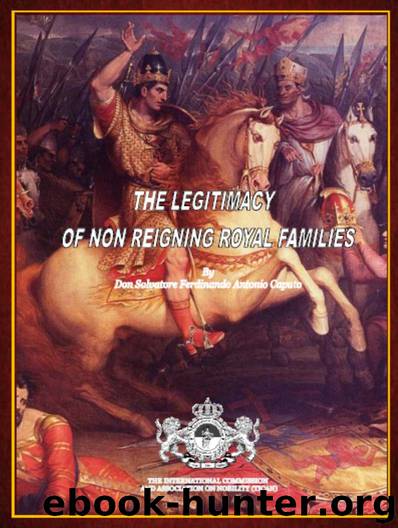The Legitimacy of Non Reigning Royal Families by Salvatore Caputo

Author:Salvatore Caputo [Caputo, Salvatore]
Language: eng
Format: epub
Publisher: UNKNOWN
Published: 2018-05-29T04:00:00+00:00
NON REIGNING DYNASTIES
Today, almost all countries have a working government that is preside over by Presidents and or Prime Ministers. There are many monarchs around the world who hold important government posts or military commands, even tough they no longer rule over their subjects.
Even if some monarchy has been long abolished, there are royal families of the world that exist and are treated with respect and honor. Some royal families like the Albania, Georgia, French, Greek, Chinese, Russian and Scottish are known as “Pretenders to the Throne”. The pretender is a claimant to an abolished throne or to a throne that has been occupied by someone else.
In fact, those sentences that ascertained that the various descendents in the different dynasties held the native right of pretender to the throne granted them the prerogative of granting noble titles and knighthoods in the Orders that their Sovereign House belonged to.
Non-regnant dynasties, whether in Italy, Germany or elsewhere, play a role in maintaining the cultural and historical identity of Old World peoples. Though hardly essential to the fabric of society, they represent not only peoples but even places. Control of dynastic orders of chivalry is at the root of certain dynastic quarrels. Some of these institutions are very old, and have a canonical position in Church law. Nowadays the few "military-religious" orders serve chiefly philanthropic purposes.
Dethroned European dynasties continued to enforce their house laws until after World War I, even though they had no legal authority to do so. Some continued doing so through the 20th century (Bourbon-Sicily, Prussia, Wurttemberg). Governments in extant monarchies, without calling the legal mechanisms house laws, have generally strengthened their control over the marriages of members of their royal families since the second half of the 20th century. Previously a prince could often morganatically marry a woman not deemed acceptable as a royal consort, relegating her and their children to a sub-royal status. That is rarely an option anymore. In most Western Europeanmonarchies of today, a prince must renounce or forfeit membership in the royal family if his chosen spouse is not deemed suitable.
Nobility in Italy
An entirely different state of affairs exists in Italy. The abolition of the Papal States, the Kingdom of the Two Sicilies, the Grand Duchy of Tuscany, the Duchies of Parma and Modena, and the incorporation of the Austrian dependencies in Northern Italy into a united Italian Kingdom, led to the establishment of a new national nobility, with an attempt (not wholly successful) to impose a uniform nobiliary law.
Italian nobiliary practices cannot be compared directly to those of other countries, such as Scotland or Russia. Even within Italy, regional differences must be considered because until circa 1870 the nation did not exist as a politically unified state.
Until the 19th century, the peninsula we now call Italy was made up of many city-states. These independent nations exist under successions of various invading empires of the French, Turks, Germans, Austrians and Spanish. The individual states, although sharing a small geographical space, were each culturally unique. They spoke separate dialects, worshiped in different churches and had unique attitudes.
Download
This site does not store any files on its server. We only index and link to content provided by other sites. Please contact the content providers to delete copyright contents if any and email us, we'll remove relevant links or contents immediately.
| Military | Political |
| Presidents & Heads of State | Religious |
| Rich & Famous | Royalty |
| Social Activists |
Waking Up in Heaven: A True Story of Brokenness, Heaven, and Life Again by McVea Crystal & Tresniowski Alex(37029)
Empire of the Sikhs by Patwant Singh(22195)
We're Going to Need More Wine by Gabrielle Union(18095)
Hans Sturm: A Soldier's Odyssey on the Eastern Front by Gordon Williamson(16928)
Leonardo da Vinci by Walter Isaacson(11935)
The Radium Girls by Kate Moore(10934)
Educated by Tara Westover(7090)
Tools of Titans by Timothy Ferriss(6985)
How to Be a Bawse: A Guide to Conquering Life by Lilly Singh(6713)
The Last Black Unicorn by Tiffany Haddish(5087)
Permanent Record by Edward Snowden(5021)
The Rise and Fall of Senator Joe McCarthy by James Cross Giblin(4854)
Promise Me, Dad by Joe Biden(4464)
The Wind in My Hair by Masih Alinejad(4435)
The Crown by Robert Lacey(4122)
A Higher Loyalty: Truth, Lies, and Leadership by James Comey(4047)
The Iron Duke by The Iron Duke(3660)
Joan of Arc by Mary Gordon(3276)
How to be Champion: My Autobiography by Sarah Millican(3199)
